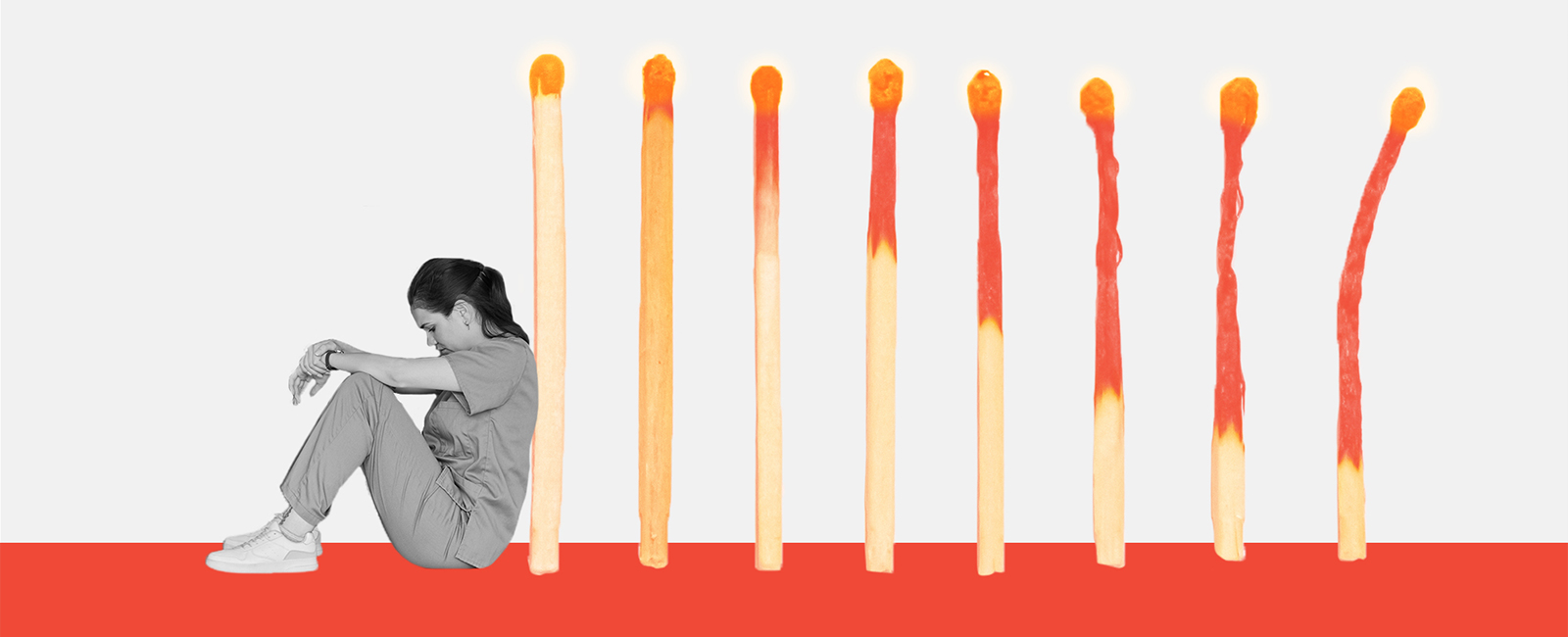It’s a familiar story by now: health care systems around the world are in crisis, facing staff shortages that — along with the stresses of working on the frontlines of a pandemic that is soon stretching into its third year — are contributing to record levels of psychological distress and burnout among health care professionals. The statistics are alarming. In the U.S., the 2022 annual survey of physicians conducted by the non-profit Physicians Foundation found that one in three physicians reported feeling “hopeless,” and the share of physicians with self-harm thoughts grew from 7% in 2021 to 11% in 2022. In Canada, the latest National Physician Health Survey (NPHS), carried out by the Canadian Medical Association (CMA), revealed that 48% of respondents screened positive for depression, and 14% had experienced thoughts of suicide over the past 12 months.
The situation is similar abroad. In Australia, which experienced some of the strictest pandemic restrictions and longest lockdowns in the world, a recent study led by Dr. Marie Bismark and a team of Australian researchers found that one in 10 Australian health care workers reported thoughts of suicide or self-harm during the COVID-19 pandemic. They also found that fewer than half of the health care workers who reported thoughts of suicide or self-harm sought professional support.
Dr. Bismark joined Ascend Magazine Editor Paul Leavoy on an episode of the Ascend Radio podcast to discuss her research findings, the mounting problem of health care burnout and psychological distress, and the enormous challenges faced by health care workers during the pandemic – something she is intimately familiar with as both a researcher focusing on the intersection between patient safety, medical regulation, and clinician well-being, and a practicing physician pursuing advanced training in psychiatry who provided mental health care in the COVID wards and emergency departments of Australian hospitals during the pandemic.
High levels of health care burnout and distress pre-date the pandemic
As Dr. Bismark discussed, high levels of psychological distress and burnout among health practitioners are not a product of the pandemic. Research has consistently shown that health care professionals were at higher risk of burnout, depression, anxiety, post-traumatic stress disorder, and suicide well before 2020.
In a large national study of suicide across different occupations in Australia between the years of 2001 and 2012, Dr. Bismark and a team of researchers found that female health practitioners were twice as likely to die by suicide as women working in other occupations, and the suicide rate for health professionals with ready access to prescription medications was higher than for those in health professions without such access or in non-health professional occupations.
Results also showed that the most frequent method of suicide used by health professionals was self-poisoning. “What we saw in our study was that many of the deaths by suicide among health practitioners used prescription medicines as the means of death,” Dr. Bismark explained to Leavoy. “If you’re a doctor and have both the access to and the know-how to use those medicines, it can be a very lethal form of suicide.”
Dr. Bismark noted that increased suicide risk among doctors has been identified in other national studies as well. “I think part of it is the stresses of the job,” she said. “I think part of it is the personality types of doctors and other health practitioners. We tend to be people who are very driven to provide great care and when things go wrong, they can have devastating consequences.”
Unique challenges of the pandemic exacerbated burnout and distress
But while high levels of psychological distress and burnout among health professionals are not new, they were certainly exacerbated by living through and working on the frontlines of a once-in-a-century pandemic. In addition to dealing with the long-standing issues that contributed to mental health issues in pre-pandemic times, health care workers faced a slew of new challenges: longer work hours and increased workload (both clinical and administrative), fears of personal and family risk, lack of personal protective equipment, financial insecurity, widespread medical misinformation, increased incidents of harassment and abuse, and the trauma of their experiences with critically ill and dying patients infected with COVID-19. Not to mention the inherent difficulty in treating a new, constantly evolving disease (and its mysterious lingering effects).
At the same time, as Dr. Bismark explained, throughout long lockdowns and other social restrictions, health care workers were deprived of the usual coping mechanisms that had helped them navigate stressful times before COVID-19. “Health care workers were saying, ‘this is the most stressful working experience of my life and all of the things that I would usually do to stay well – like going to the gym or going for a swim or catching up with friends or singing in a choir – have all been taken away from me,’” she said.
Why aren’t practitioners getting the help they need?
Although Dr. Bismark noted that things are slowly changing – especially among younger practitioners, who are more likely to seek help than older peers – stigma remains a major reason why health care practitioners aren’t accessing treatments. “I think there is still some internalized and institutional stigma around health practitioners seeking help for mental health issues,” she said.
But there are other barriers as well. Many jurisdictions require practitioners to disclose mental illnesses as part of their licensing and renewal processes, which can discourage them from seeking treatment. A 2017 study found that physicians are most likely to be reluctant to seek treatment in U.S. states with the most sweeping questions about mental illness on their licensing applications. And in the Physicians Foundation’s 2022 annual survey, nearly four in 10 physicians reported they were either afraid or knew another physician fearful of seeking mental health care because of questions asked in medical licensure, credentialling, and/or insurance applications.
In Australia, as Dr. Bismark explained, there’s a legal requirement for mandatory reporting if a health practitioner, employer, or education provider reasonably believes that a health practitioner is placing patients at a substantial risk of harm due to an impairment. “The threshold for reporting is very high,” she said, “but unfortunately there are a lot of misunderstandings about that law, so some doctors are fearful to seek help for their mental health issues in case they are reported to the regulatory authority.”
Solutions must address root causes, remove barriers to seeking treatment
So, what can be done to help? Unfortunately, there isn’t a ‘quick fix,’ as it will take a multi-pronged effort to fix the long-standing, systemic issues in health care that are significant contributors to health care burnout, address labor shortages that are further exacerbating the problem, and eliminate the stigma associated with health practitioners seeking mental health treatment. But there are several actions that employers, medical boards, and policymakers can take in the near term that would make a major difference.
At the employer level, advocates say that health care organizations should both improve working conditions and implement comprehensive well-being programs that directly address mental health and burnout. As Dr. Bismark explained, over the past few years, many employer-run solutions have focused on building resilience rather than dealing with root causes. “I think that many employers tried to respond to this distress during the pandemic by offering a new well-being app, or running a resilience course, or suggesting some lunchtime yoga, and many health practitioners perceived those interventions as quite tokenistic,” she said.
In fact, Dr. Bismark’s research showed that there is nothing wrong with the resilience of health care workers. “What we found was that health practitioners, perhaps not surprisingly, are already a very resilient group,” she explained. “We assessed health workers’ resilience and it was higher than the general population. But yet we were seeing these very high rates of anxiety, burnout, and depression.”
Instead of resources to bolster their resilience, health practitioners told researchers they needed safer and more supportive working conditions. “What they said to us was that they needed adequate staffing; they needed appropriate personal protective equipment; they needed the ability to take time off when they were exhausted; they needed leaders to understand what conditions were like on the front line,” Dr. Bismark said.
There are several potential solutions that could improve working conditions. ALL IN: WellBeing First for Healthcare, a campaign developed by #FirstRespondersFirst and The Dr. Lorna Breen Heroes’ Foundation, provides a Healthcare Workforce Rescue Package for leaders with evidence-based actions that can be initiated within three months. Among those top recommendations, identified by a group of experts in collaboration with the National Academy of Medicine, were finding ways to give clinicians more flexibility and autonomy, and working with clinicians to identify and remove low-value work through process improvements. Physicians consistently rank too many bureaucratic tasks and lack of control/autonomy in their lives as major causes of burnout.
The experts also recommend providing additional mental health counseling resources and peer support networking programs beyond standard EAP efforts. Connecting practitioners to other medical professionals with shared lived experience can not only alleviate suffering, but could also reduce internalized stigma associated with seeking treatment. “We know for many health practitioners they feel more comfortable speaking to a trusted peer or a trusted colleague than an independent third party,” Dr. Bismark noted.
Depending on the jurisdiction, regulatory (and, if necessary, legislative) changes that address mandatory reporting and/or disclosure requirements for licensure could be part of the solution, too. To ensure that licensing questions don’t act as a barrier to seeking mental health treatment for practitioners, the Dr. Lorna Breen Heroes’ Foundation urged medical boards in the U.S. to conduct an audit of their licensing applications and change any invasive or stigmatizing language around mental health. Specifically, it recommends that boards ask only one question consistent with the Federation of State Medical Board’s recommended language that addresses all mental and physical health conditions as one; refrain from asking probing questions about an applicant’s health; and implement an Attestation Model that uses supportive language around mental health and offers “safe haven” non-reporting options to physicians who are receiving treatment. As of August 2022, 17 states had aligned their applications to meet these recommendations.
Urgent action is needed to address health care burnout and distress
Solutions will vary by workplace setting, specific profession, and jurisdiction, but experts and advocates emphasize that urgent action is needed. Nearly three years of sacrifice on the frontlines of a pandemic that refuses to quit are taking a significant toll on health care professionals everywhere. Health care workers have been quitting in droves; some are cutting back their hours; and too many are still suffering in silence.
The health care professionals who dedicate their lives to caring for us and our loved ones – including those who treat our four-legged companions, who are experiencing similarly high rates of psychological distress and burnout – deserve the same level of care and compassion that they give to us every day. But addressing health care burnout and distress is not only the right thing to do, it’s necessary to protect the capacity of health care systems and ensure high quality patient care, as research shows that burnout has adverse outcomes on patient care and the health care system. The well-being of physicians and their patients are inextricably linked, and as Dr. Bismark noted, you can’t provide great patient care unless you take care of the well-being of health practitioners as well.
To hear the full conversation between Dr. Marie Bismark and Paul Leavoy, listen to this episode of the Ascend Radio podcast. Alternatively, read Part 1 and Part 2 of their conversation. In addition to discussing clinician well-being and mental health, they also talk about Dr. Bismark’s professional and academic journey, her research on sexual misconduct complaints and regulatory responses to them, her recent book, “Experiences of Health Workers in the COVID-19 Pandemic: In Their Own Words,” and more.
MORE INSIGHT

‘The people piece’: The key role of people in regulatory transformation
Regulatory transformation is not only about changing an organization’s technology and processes; it is also about empowering and engaging its people throughout the journey. In this article, Rick Borges looks at the key role that people play as enablers of regulatory transformation.

Playing in the sandbox: Old regulators are learning new tricks
Regulators are increasingly turning to an innovative policy tool called a “sandbox” to address various challenges. In this article, Contributor Will Morrison explores the origins of regulatory sandboxes and how they work.

Regulators tackle operational resilience in the UK
To mitigate the risk of major operational failures affecting the day-to-day lives of millions of financial services customers, U.K. regulators issued new rules on operational resilience that came into force in March 2022. In this article, Rick Borges looks at the requirements and the impact they will have on firms’ cyber resilience and use of third-party providers.

An exhaustive breakdown of interstate compacts in the U.S.
Just how many interstate licensing agreements are active in the U.S.? And in which professions are regulators looking to further promote license mobility? In our latest Ascend article, we take an in-depth look at the country’s largest active and pending multistate licensing agreements.

How the U.K.’s new Consumer Duty will change how firms operate
On July 31, the U.K.’s Financial Conduct Authority (FCA) will begin enforcing a new Consumer Duty that will set higher and clearer standards of consumer protection across financial services and require firms to put their customers’ needs first. In this article, Ascend Contributor Rick Borges explores the impact this change will have on how firms operate.

Cayton asks ChatGPT: Is AI a good thing or a bad thing?
Is AI a good thing or a bad thing? It’s a question that’s currently top of mind for lawmakers and citizens alike as the development of increasingly powerful AI technologies continues at a rapid pace. As Harry Cayton recently contemplated this question, he decided to ask ChatGPT to see what it had to say.








